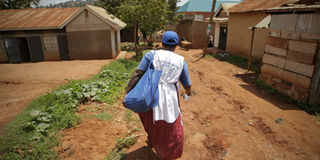Fighting Child mortality one knock at a time

An agent with an a community health initiative aimed at reducing child mortality rates out in the field. PHOTO BY CHRISTINE W. WANJALA
What you need to know:
Uganda, according to the World Health Organisation, is one of 24 developing countries with a high mortality rate. It is no wonder that a health initiative aimed at reducing this rate was recently recognised. Christine W. Wanjala tagged along to see how it works.
The long winding road unfurling into the green farmland promises a long walk. In spite of her slight frame, Betty Nanyonga, does not seem daunted by the distance or the two blue clearly laden bags she has to haul as long as she is going on this particular trip. She carries one on her shoulder and the other on her arm and sets off briskly.
It is just as well that the sun is obscured by clouds as it rained the previous night a blessing as it would be impossible to keep up with Nanyonga in warmer weather.
Many of the residents of the village in Mpigi District are out in their gardens, taking advantage of the good weather to catch up on their weeding. Still Nanyonga feels the people who she is hoping to see will be at home. Nanyonga is an agent of Living Goods, a health initiative that uses community health promoters to reach out to communities in an effort to reduce mortality in children under five as well as maternal deaths. The new mothers, those still expecting and children under five, are likely to be exempted from the garden work.
The health products
In her bags, Nanyonga carries the tools of her trade, some medicines for the five major treatable diseases in children under five which are also known to be the biggest killers namely diarhoea, malaria, pneumonia and worms.
She also carries some nutrition products such as a special enriched porridge, some solar lamps as well as several mama kits to sell to expectant women. Sometimes she carries reusable sanitary towels, energy saving stove, soap and condoms for sale.
In a day’s work, Nanyonga will sell these products, door-to-door in the village she grew up in, check on people she had sold drugs to in the recent past, advise those who do not seem to be getting better to visit a hospital, register expectant mothers and newborns and do follow-up visits on those she already registered as well as liberally dish advice on newborn care not forgetting seeing to it that expectant women are going for their antenatal visits.
Her first stop on this Tuesday afternoon is a small mud-brick house. The family of five recognises her. The mother of the house calls out hearty greetings to Musawo.
Today the mother of three, Oliver Namutebi, is not buying anything. Her children, all under five, are hale and hearty. Since Nanyonga started doing her rounds mid-last year, she says the story has changed from when her children lived with persistent coughs and herbs that were not helping. “She explained very well that I have to treat cough early with cough medicine and I saw a difference,” she says.
In Kampala
A few hours earlier, back in Kampala Justine Kiwanuka had set off on a mission similar to Nanyonga’s.
A field agent in Kawempe and attached to Living Goods pioneer branch in Tula, her area of operation with its houses built closely together and both human and vehicle traffic on its narrow roads is a lot different from where the rolling hills Nanyonga combs. But both areas, as with the most of the country, see high incidence of the treatable childhood illnesses and they are busy through out. Kiwanuka, a retired teacher and grandmother to five, has been at it longer though.
Some of the newborns she registered are now outgrowing the target age group of under-five. “She has been treating some of these children since they were born,” says Mary Namubiru, the matriarch of the first home Kiwanuka visits that midmorning. There are four children under five in Namubiru’s household and one of her older daughters is expecting, so soon they will be five.
Here, the hospitals may not be that far, if anything, there seems to be a clinic or dispensary every other door. But treatment for malaria, cough, diarhoea and worms hit for all four young ones every time any of the children falls ill was proving to be an expensive affair.
That Tuesday, the family is all well, and after Kiwanuka shows a few nutritional product she has and reminded the expectant mother to go for her next antenatal visit, it is time to leave.
The use of community health champions or village health team’s strategy is not new. It has been tried in everything from HIV to promotion of safe drinking water. However, challenges in keeping the village health team actors who were usually volunteers motivated, enabled, equipped sounded the death knell for the strategy which is currently in review.
Since its launch by serial entrepreneur Chuck Slaughter who borrowed on cosmetic brands Avon door to door model, Living Goods has shown it has somehow figured out a way around the above listed issues. For instance 22 of the pilot team of community health promoters are still working.
“Our agents are not volunteers, neither are they salaried,” said Alfred Wise the country director Living Goods in a short interview shortly after receiving an award on behalf of the initiative. Instead, the model is designed such that they make a reasonable profit from the goods they sell. This makes the effort worth their time. If they do not sell, they make nothing.
Health promoters like Nanyonga then buy the products from the organisation at a heavily discounted price. They in turn sell at a small profit thus keeping the goods below market price as several members of the community revealed.
Training involved
New agents get an intensive three-week training, in identifying and treating malaria, diarrhoea, worms, and pneumonia and or cough, as well as basic new born care maternal health as per Ministry of Health guidelines on training village health teams.
Currently, the single mother of two’s greatest pride is her certificate which proves she completed the course and is qualified to operate in her community as a “musawo” albeit that she is restricted to a few diseases and is required to refer to a medical hospital. “I feel proud to also be called Musawo. I learnt a lot and I am helping my community with my knowledge,” she says.
She may not have spent years in medical school. But as long as the nearest hospital is kilometres away and children still frequently fall ill and sometimes die from treatable illnesses like diarhoea, and malaria her daily trips are all important.
Tracking patients
Up to last year, Betty Nanyonga, an agent for Living Goods, a health initiative, would register new mothers, as well as any cases she had treated in a book.
In December, the organisation introduced its agents to the convenience of paperless record keeping in the form of a phone application.
The app reminds them to do follow-up visits with people they visited. It also reminds the agents and the expectant mother whom they have registered that it is time for her next antenatal visits. If symptoms are entered, it brings up the diagnosis and the exact dosage and reminds the agent and the caretaker of the young patient it is time to administer the medication, reducing chances mistakes.




